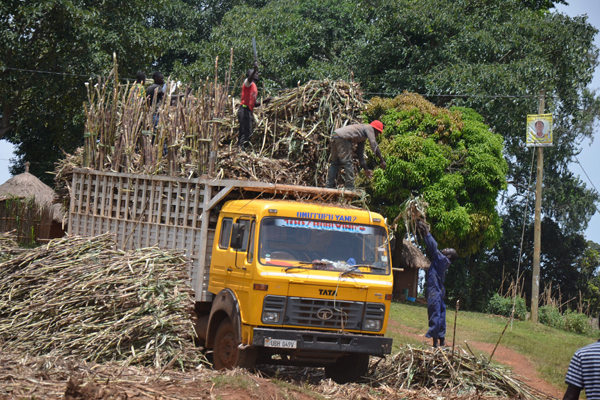Busoga sugar mills can now crush more

People load sugarcane onto a truck in Jinja District. PHOTO | File
What you need to know:
- The move will increase the demand in sugarcane and its prices
Sugarcane farmers in Busoga Sub-region have reason to smile following news that millers’ crushing capacity has increased.
This comes after various companies expanded the capacity of their millers to accommodate the surplus in the sub-region.
Due to low crushing capacity earlier, prices of sugarcane had reduced from Shs175,000 per tonne in 2017 to Shs96,000 per tonne.
Mr Isa Budhugo, the chairperson Busoga Sugarcane Out growers’ Association (BSGA), said the capacity was 13,000 tonnes per day, but it was expanded to 26,000 per day.
Currently, Busoga Sub-region has six sugar factories, including Kakira Sugar Works (Jinja), Mayuge Sugar Factory (Mayuge), Kamuli Sugar Ltd (Kamuli), Kaliro Sugar Ltd (Kaliro), GM Sugar Factory (Buikwe) and the newly-constructed Bugiri Sugar Ltd (Bugiri), which is expected to begin operations in December.
According to BSGA records, Busoga Sub-region has at least 30,000 large-scale farmers.
“Kamuli Sugar, for example, has been crushing about 150 trips of cane, but by April next year, it will start crushing 550 trips; Mayuge Sugar, which has been crushing about 300 trips, has expanded to 600 trips, while GM sugar will in October start crushing 300 trips and Bugiri Sugar will start operating with a crushing capacity of 250 trips per day,” Mr Budhugo said.
Mr Budhugo said Kakira Sugar Works Ltd is expanding and will be crushing 10,000 trips per day, adding that its crushing capacity has doubled from 13,000 tonnes per day and by April next year, all available mills in Busoga will be crushing 26,000 tonnes per day.
He added that farmers have about 10 million tonnes of sugarcane, but the millers only had the capacity to crush 4.5 million tonnes at full capacity.
Mr Budhugo said farmers have been taking their produce to far areas such as Kenya and Atiak Sugar Factory in northern Uganda.
In June 2019, BSGA signed a Memorandum of Understanding (MoU) with Kenya to supply sugarcane to Olepito Sugar Company in western Kenya after the available sugar millers failed to consume their surplus.
The contract, which lasted for three months, was cancelled following high competition.
On January 11, 2020, the Bishop of Busoga Diocese, Rt Rev Paul Naimanhye, flagged off 50 sugarcane trucks to Atiak Sugar Factory in northern Uganda as a first consignment, following farmers’ frustration over falling prices of raw cane and lack of market.
The deal was, however, hampered by inadequate vehicles to carry cane to Atiak.
“We (Uganda) have the lowest prices of sugarcane, with a tonne going for Shs96,000; while in Kenya a tonne goes for Shs150,000 and Shs160,000 in Tanzania. The expansion of the crushing capacity will increase demand for cane and the prices will automatically increase,’’ he said.
Farmers’ frustration earlier
Mr Anthony Kirya, a sugarcane farmer in Wairasa Sub-county, Mayuge District, said he has been operating under losses because his cane has been drying up in the gardens due to low demand.
Mr Patrick Wegesa, another farmer, said he was about to abandon sugarcane farming over low profits.
Mr Musa Kabugo, a sugarcane farmer in Kamuli, said: “The prices motivate a farmer to grow more sugarcane, but it has currently dropped to Shs96,000 per tonne, prompting farmers to resort to growing maize.”



